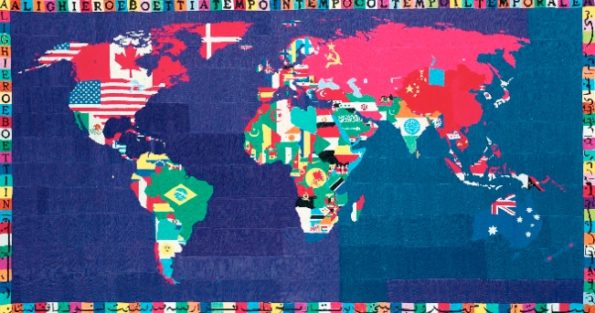Search
To search for an exact match, type the word or phrase you want in quotation marks.
A*DESK has been offering since 2002 contents about criticism and contemporary art. A*DESK has become consolidated thanks to all those who have believed in the project, all those who have followed us, debating, participating and collaborating. Many people have collaborated with A*DESK, and continue to do so. Their efforts, knowledge and belief in the project are what make it grow internationally. At A*DESK we have also generated work for over one hundred professionals in culture, from small collaborations with reviews and classes, to more prolonged and intense collaborations.
At A*DESK we believe in the need for free and universal access to culture and knowledge. We want to carry on being independent, remaining open to more ideas and opinions. If you believe in A*DESK, we need your backing to be able to continue. You can now participate in the project by supporting it. You can choose how much you want to contribute to the project.
You can decide how much you want to bring to the project.

“We live, die and love in a squared space, […] with bright and dark areas, with drops, steps, depressions and bumps…” With this reflection, Michel Foucault reminds us of the similarities between passing through life and the detailed topographical analysis of a territory. Maybe our idyll with cartography arises from this. The exhibition “Cartografías contemporáneas. Dibujando el pensamiento” (Contemporary cartographies. Drawing thought) on show at the Caixaforum, explores the obsession with fragmenting reality, physical space as much as of intangible elements, to translate and codify them within a rational structure. The wide variety of works presented— 140 works by artists from the 20th and 21st centuries— shows that the eagerness to seize the world through the segmentation of space has led us to create maps of all sorts, to represent even metaphysical features such as dreams.
In cartographical terms, the language of the map translates reality with a supposedly objective distance, one that aims to represent without judging, simply gathering data to transmit them with scientific exactitude. However, the exhibition aims to reveal how this is only partly the truth. The different areas of the exhibition try to reveal the structure of the logical order that the cartographical language imposes on the world. An order, that grids up the world according to power relations and cultural differences. The selection of works that makes up the exhibition questions the limitations that this implies regarding the perception of our surroundings.
The exhibition is divided into 5 spaces that endeavour to break down the different applications of cartography within artistic creation. The different spaces represent elements in the code of a complex conceptual map that describes the terrain of contemporary cartography. The first space, “Social and political cartographies” supposes a critique of the geographical discourse, the very essence of cartography, and a point of departure that directs, without disorientating, the spectator. Given the nature of these works and their proximity to the common idea of a map, it ends up being easy to decipher the code, to be able to see the different existing social and political orders that the artist has wanted to highlight.
Passing through to the following space, “Cartographies of the body”, the conceptual nature of the map takes on a significant prominence. While it is true that the texts accompanying each section incite reflection, the information that the exhibition provides about each piece undermines the potential scope of these reflections. In the same way, in the following 3 spaces, the works take a decisive step away from the common concept of the map to show the reach of cartography as a tool for artistic research. The relation to the intangible is what defines the majority of the works presented in the spaces of “Cartographies of experience and life”, “Cartographies of the intangible” and “Conceptual cartographies”. These works show the need to make visible maps of less studied aspects of human experience.
Here is precisely where the paradox of the exhibition is revealed, the endeavour to create a three dimensional plan of contemporary maps. In this sense, the show is yet another example of cartography, a sort of topographical route through the different artistic uses of the map. A plan, configured according to lines determined not so much by the disciplines employed as by human logic, that divides and unites according to its own criteria, determined to categorise and compare, making another squared and rationalised territory out of terrain of cartography, when what these works seek to do is question the straight lines that logic imposes on the world. The result is a journey through a highly codified map, where the background of the sometimes exhibition doesn´t transcend the works.
As the discourse advances, the questions provoked by the complexity of the cartographic language accumulate and the quantity of data multiplies, complicating the spectator’s advance through an unknown territory. Just as with military maps, normally only decipherable by someone who is well versed, the exhibition introduces profound ideas, with huge potential, but in a very abrupt manner, without enlisting the spectator’s true comprehension. The visual information is impressive and the explanatory texts are of a high standard, however, the description of the elements that make up the pieces and the message that each map tries to communicate end up being vague. The aim of the exhibition to create a showcase for contemporary artists who use the cartographical language is achieved, but one regrets the approach and loss of its initial potential.

Verónica Escobar Monsalve is a restless soul, with a digital nature and an analogue heart. Her investigations centre on art and culture that mix the digital world with pre-digital thought. Art and culture that is capable of reflecting the complexity of today’s world. She believes in the vital importance of a critical spirit and how this can be applied to any facet in life, however difficult it may be.
"A desk is a dangerous place from which to watch the world" (John Le Carré)